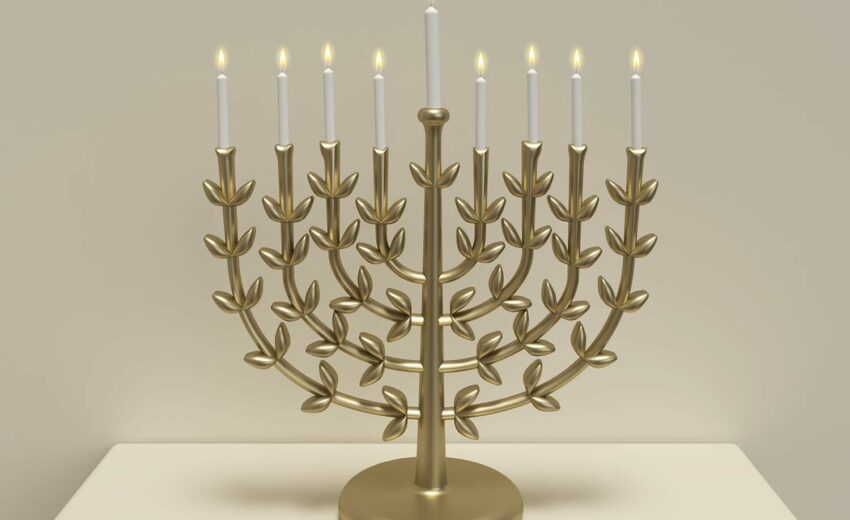
Rabbi Jeffrey Falick of The Congregation for Humanistic Judaism of Metro Detroit shares the history of the Hanukkiah. The transliteration from Hebrew to English letters follow the writer’s choice
We know that the story of the oil was recorded in the Talmud and it is late-ish, ca. 500 C.E.
However, its mention there undoubtedly postdates the tradition of kindling holiday lights. We know this because that is alluded to already by Josephus in the first century C.E. He calls our holiday the “Festival of Lights [phôta in Greek]” (see Antiquities 12.7.6-7 316-325; based upon 1 Maccabees 4:36-59). But while Josephus is the first to mention “lights,” he does not mention any oil miracle.
Now on to the issue of Chanukah lamps:
It is quite probable that the early Chanukah lamps were not in the shape of the seven-branched menorah. (I have a video posted below.)
As for Chanukah menorahs in the design of the seven-branched Temple Menorah (https://en.wikipedia.org/wiki/Temple_menorah), these appear to be very, very late. To explain why I believe this, it is important to first understand the real halakhic (Jewish legal) concept of the shamash, i.e., the so-called “helper candle.”
We have all grown up learning that the shamash is the candle used to light the other candles and this is correct today. However, at least in Ashkenazi lands it was also the candle (more accurately, the wick) which also provided the light for “seeing.” What do I mean by “seeing?”
According to the Babylonian Talmud Shabbat 21:b, the lights of Chanukah cannot be used for the normal purpose of seeing things! They are kindled solely for the purpose of pirsuma nisa, Aramaic for “publicizing the miracle.”
How is it possible to have lights present that you don’t use to see things? According to rabbinic thought, you add a light next to them. Its light then gets mixed with those miracle-publicizing lights, providing the actual light for seeing things. This is well known among traditional Jews.
Here’s how the Babylonian Talmud Shabbat 21:b puts it:
Rava said:
One must kindle another light in addition to the Chanukah lights in order to use its light, as it is prohibited to use the light of the Chanukah lights. And if there is a bonfire, he need not light an additional light, as he can use the light of the bonfire. We turn next to the Shulchan Aruch, written in the 1560’s by Rabbi Joseph Karo for Sephardim and amended at about the same time by Rabbi Moshe Isserles for Ashkenazim. Today it is considered by traditional Jews to be the most definitive guide to Jewish law. What does it have to say about how they handle the issue of an additional light?
In Shulchan Aruch, Orach Chayim 673.1, Karo explains:
We have the custom to kindle an addigonal light … and it should be placed at a small distance from the other obligatory lights.
Isserles notes that the Ashkenazim do it a bit differently:
In our countries, we do not have the custom to add [a light]. One only places by the Chanukah lights the auxiliary light with which he kindles the them…. [I]t should be made longer than the other lights, so that if he comes to use [its illumination for “seeing” things ], he will use that light.
Isserles refers to this “auxiliary light” as the shamash. This is the first time it’s ever mentioned! This makes it quite unlikely that there was an imitation of the seven-branched Temple menorah in early use. Only Rabbi Isserles’ description would easily accommodate a longer (or elevated or otherwise set apart) separate light that did both the job of lighting the miracle-publicizing lights and of providing “seeing” light after that. That’s just my conjecture, of course.
Since the Ashkenazic Isserles is describing an existing custom we can’t know exactly how long it was around. But the fact that the Sephardic Karo describes a different custom leads me to infer that Isserles’ Ashkenazic custom is not so very, very ancient. The Ashkenazic community only takes off in the 11th – 12th centuries.
So when did the earliest Chanukah menorahs that looked like the seven-branched Temple Menorah first appear? Most speculation says that they’re probably not much older than 500 600 years old. Perhaps more, probably less.
The earliest styles of the chanukia (plural: chanukiot; originally an 18th c. Sephardic portmanteau of Chanukah and Menorah now used in Modern Hebrew) probably looked nothing like today’s seven-branched Temple Menorah.
Here’s a 14th c. Sephardic example:

Note that it is not for candles. Many did not use candles, but wicks and oil. That’s still the preference among many, especially more traditional Jews.
You can buy pre-filled oil cups that can be seated in the candle holders of modern chanukiot:

Or you can also buy little floating wicks for chanukiot that have built-in oil cups:

To conclude let’s go back in time. Here is an ancient chanukiah (6th – 8th c. C.E.). It’s used with little wicks and has no place for a ninth light. It’s very small and portable, indicating that it may have been for Jews who were in danger of expulsion. It also looks nothing like a seven-branch Temple Menorah:

Even further back in time we would not have had chanukiot of any kind. People would have simply lined up their household lamps. Here’s a video to help visualize that
Notice that the ninth lamp has nothing to do with lighting the others. In this video it is – as the Talmud and Karo both explain – just an extra lamp for “seeing” things.
– Rabbi Jeffrey Falick




Leave a Reply